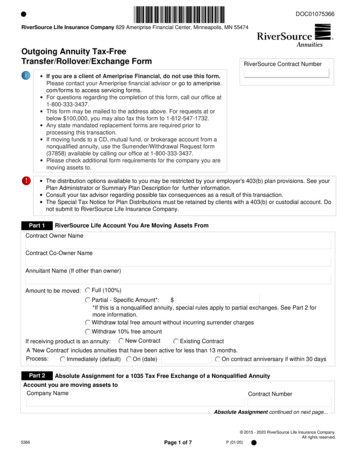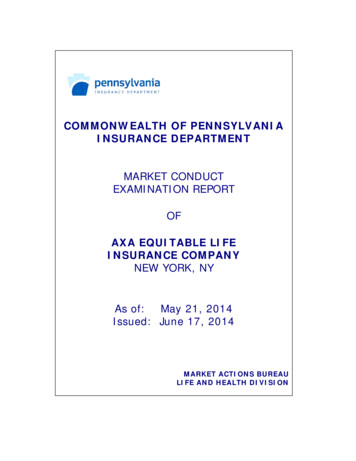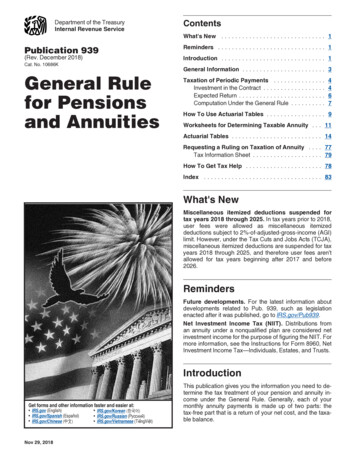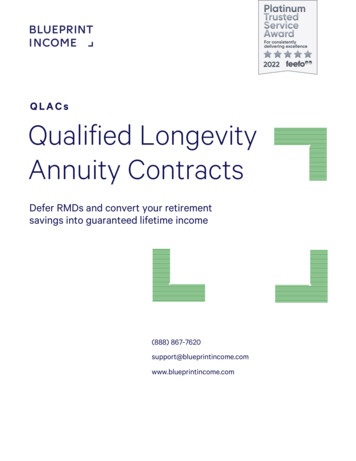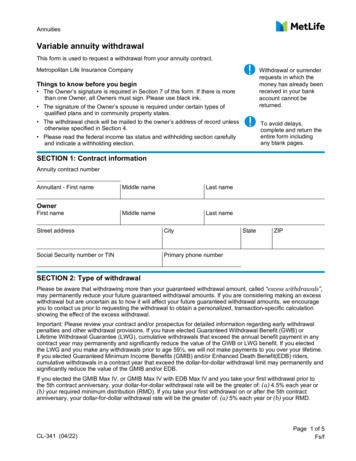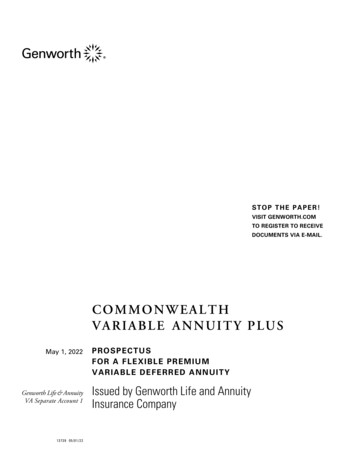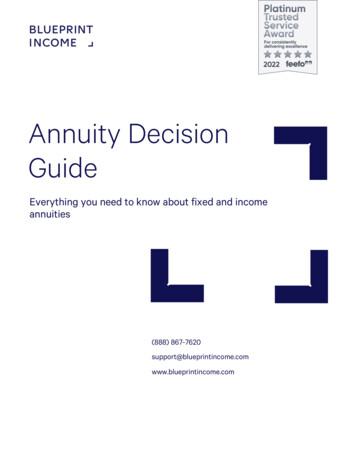
Transcription
Annuity DecisionGuideEverything you need to know about fixed and incomeannuities(888) come.com
IntroductionIf you’re thinking about retirement and feeling insecure about the permanence ofyour finances, we wrote this guide for you. In the post-pension era, creating asecure retirement is certainly more complicated. Instead of retiring with acontinuation of your salary, you’re forced to figure out how to invest, manage, andwithdraw from your savings to meet your spending needs. It’s a challenge, but youhave options.One of those options is to buy an annuity. At Blueprint Income, we only providethe simplest annuities out there. There are fixed annuities to provide guaranteedreturns that are not affected by market movements. And there are incomeannuities to provide guaranteed income that continues as long as we live.The purpose of this guide is to introduce you to annuities, the good and the bad,and provide you with the education you need so that you can decide what makesthe most sense for your retirement. Even if you don’t read it cover-to-cover, wehope you heed our advice in three important areas:1.Buy an annuity for its guarantee. If you can’t figure exactly how much anannuity will pay you in the future, you shouldn’t buy it. Period.2.If you have multiple goals for retirement, segment your portfolio andaddress each need separately. Products that promise to do everything donothing well.3.Be diligent about seeing the whole market and getting the best price atthe credit rating you prefer. Since you’re buying an annuity for itsguarantee, the rating matters.We hope you find this guide helpful. Please feel free to call or email us with anyfeedback or questions.To your longevity,The Blueprint Income Teamwww.blueprintincome.com (888) 867-7620 support@blueprintincome.com2
A Quick Guide to AnnuitiesTypes of AnnuitiesAn annuity is a contract between an individual and an insurance company.Fundamentally, an annuity can provide steady, guaranteed lifetime income to theindividual. In entering into an annuity contract, an individual is able to offloadunwanted risks, namely market and longevity risks, to the insurer. Originallyannuities did only that, but over time new versions have been created with othervalue propositions, demoting guaranteed income via annuitization to just an optionavailable. The following are the types of annuities out there:Fully guaranteed income or return.Available at blueprintincome.com.Insurance/investment hybrid.Not available at Interest creditedTrack indicesInvested in fundsLifetime monthlyincomeFixed growth ratePreserving principleVaries by productNoNoYesYesLower one-timecommissionsLower missions/feesSingle premiumimmediate annuities(SPIAs)Multi-year guaranteedannuities (MYGAs)Fixed indexed . &PRODUCTVERSIONSDeferred incomeannuities (DIAs)Fixed rate annuitiesFixed deferred annuitiesLongevity annuitiesQualified LongevityAnnuity Contracts(QLACs)www.blueprintincome.com (888) 867-7620 support@blueprintincome.com3
Deciding Which Annuity Is Right for YouA fixed annuity provides a guaranteed return for a set number of years. Anincome annuity takes a portion of your retirement savings and converts it intoguaranteed lifetime income.Use the following decision tree to figure out which type of annuity is right for you:Fixed AnnuityGrowthI wantguaranteed IncomeI want topay for it NowIncome AnnuityAvailable as:Immediate annuityLongevity annuityQLACContinue reading to learn more about the type of annuity that best meets yourneeds.www.blueprintincome.com (888) 867-7620 support@blueprintincome.com4
Table of ContentsFixed Annuities6Income Annuities28Types of Income AnnuitiesImmediate AnnuitiesLongevity AnnuitiesQualified Longevity Annuity Contracts (QLACs)29304871Insurers92About Us93www.blueprintincome.com (888) 867-7620 support@blueprintincome.com5
Fixed AnnuitiesA safe, guaranteed and tax-deferred way to growyour retirement savingswww.blueprintincome.com (888) 867-7620 support@blueprintincome.com6
FIXED ANNUITIESIntroductionLike many Americans, you’ve taken your retirement seriously and have beencontributing to your 401(k) and IRA. As qualified retirement savingsvehicles, they allow you to save pre-tax money and let it accumulate on atax-deferred basis until retirement. But, there are limits to how much can becontributed annually, and they often don’t offer guaranteed investmentoptions.Let’s say you are getting closer to your retirement age goal, you’ve eithermaxed out your 401(k) and IRA contributions and/or are looking for adecent return with a minimal amount of risk. You like the security of a CDbut wish you could get a better return. The good news is there is anotheroption.A fixed annuity is essentially a certificate of deposit (CD) sold by aninsurance company and without the backing of the FDIC deposit insuranceprogram. While CDs are great for low-risk short-term savings, fixedannuities are more suited to retirement savings, offering: Typically higher crediting rates over longer time horizons, tax-deferred growth, the ability to annuitize at the end of the investment term, and liquidity via penalty-free partial withdrawals.CONTENTSWhat Is a FixedAnnuity?Fixed Annuitiesvs. CDsBenefitsDrawbacksTypical BuyersFinancial ValueTaxationPortfolio StrategiesFeatures & RidersBuying TipsFixed annuities are also known as multi-yearguaranteed annuities (MYGAs), fixed rate annuities,fixed deferred annuities, and single premiumdeferred annuities.In this guide, we’ll provide an overview of fixed annuities, covering howthey work, what makes them an appropriate (or inappropriate)investment for you, and how to approach the buying process.www.blueprintincome.com (888) 867-7620 support@blueprintincome.com7
FIXED ANNUITIESWhat Is a Fixed Annuity?A fixed annuity is a tax-deferred retirement savings vehicle that provides fixed asset accumulation,much like a CD. With a fixed annuity, you can invest your savings over a specified time horizon(typically 3 to 10 years), earning a fixed return. The interest earned in your fixed annuity is not taxeduntil withdrawn, and your principal is guaranteed.Because annuity terminology – and the fact that a fixed annuity is an annuity in the first place – isconfusing, let’s break it down:A fixed annuity is an annuityAn annuity is an insurance vehicle where a lump-sum amount is exchanged for a stream ofpayments going forward. What makes a fixed annuity an annuity is that it has the option toannuitize, or get the stream of payments, at the end of the investment term. You can also choose toleave your money invested at a renewable rate, withdraw all or a portion, or roll it over into a newfixed annuity. The distinction of being an annuity gives it its tax-deferred status.www.blueprintincome.com (888) 867-7620 support@blueprintincome.com8
FIXED ANNUITIESMore specifically, a fixed annuity is an accumulation annuityAn accumulation annuity is bought for the growth potential of the money invested, and not as muchfor the ability to turn that money into income (as is the case with an income annuity). During theaccumulation, or deferral, period your money will be invested with an insurance company and growon a tax-deferred basis. You will often have some access to your money – typically the interestaccrued or 10% of your balance – while it’s invested. Accumulation annuities grow either at a fixedrate (like fixed annuities) or grow based on market performance (as with variable and indexedannuities).And finally, a fixed annuity is a multi-year guaranteed accumulationannuityFixed annuities earn a fixed rate over a multi-year time horizon. The interest rate will be specifiedupfront and will vary based on the amount you’re investing, your investment term, the credit ratingof the insurer, and market conditions at the time of purchase. At the end of the guarantee period,the rate may change.In summary, a fixed annuity is an annuity that operates much like a CD, offering low-risk taxdeferred accumulation at a fixed rate.www.blueprintincome.com (888) 867-7620 support@blueprintincome.com9
FIXED ANNUITIESFixed Annuities vs. CDsFixed annuities operate very similarly to CDs. Both vehicles offer a safe way to save money, creditinginterest rates typically higher than what’s available through savings accounts by requiring you to lockyour money away for a period of time. However, fixed annuities have longer investment terms and taxpreferential treatment, making them a better choice for retirement savings. As CDs are the more wellknown of the two products, it can be easier to understand fixed annuities using a side-by-sidecomparison:FIXED ANNUITYCDSold ByInsurance companiesBanksSize 2,500 – 1,000,000Virtually any denominationTerm2 – 10 years3 months – 5 yearsInterest RatesVary by term and size but typicallyhigher than CD ratesVary by term and size but typically lowerthan fixed annuity ratesTaxesTaxes on interest gains deferred untilmoney is withdrawnInterest taxable annually as earnedLiquidityTypically a portion of the accountbalance is available for withdrawalannuallyGenerally no (free) access to accountbalance is availableWithdrawalProvisionsCan generally withdraw accumulatedinterest or 10-15% of account balance forfree if age 59½ or olderAll withdrawals are charged, typicallyequal to a portion of the interest you’veearnedFinancialProtectionBacked primarily by the issuinginsurance company, and additionally byState Guaranty FundsInsured by the FDIC (up to 250,000total per bank)LegacyAsset passed directly to beneficiarywithout going through probate processProbate process required to pass assetto heirsDoes not cover all products or all companies. Specific information available by product upon request. Updated as of June 2020.* Fixed annuity premiums of more than 1,000,000 may be possible with insurer’s approval.Another key difference is that fixed annuities can be annuitized at the end of the investment term.Annuitization is the process of turning savings into a stream of steady income, guaranteed to last anumber of years or for life. This feature is what makes annuities good for retirement income andqualifies them for tax-preferential treatment.www.blueprintincome.com (888) 867-7620 support@blueprintincome.com10
FIXED ANNUITIESBenefitsFixed annuities are a useful tool for retirement savings. They provide a safe, tax-advantaged way toearn a good return on savings needed in the near future. They are very similar to CDs, with addedbenefits: Guaranteed, Strong ReturnThe money you invest in a fixed annuity will accumulate at a fixed rate, which is specified upfront andguaranteed for the entire investment term. Fixed annuities generally offer higher rates than CDs withthe same investment term length. Tax-Deferred GrowthFrom the government’s perspective, an annuity is a retirement savings vehicle. As such, no taxes arepaid until distributions are made. For a fixed annuity, this means that interest will accumulate andcompound without incurring annual taxes, as is the case for a CD. Principal ProtectionUnlike with most other investments, there is no market risk associated with a fixed annuity. Yourprincipal is protected and guaranteed to accumulate at a fixed rate, making fixed annuities a goodplace to park retirement money you don’t want to risk losing. Some LiquidityFixed annuities provide some liquidity, typically making interest earned or 10-15% of the contract’saccount balance available penalty-free annually if you’re over 59½.www.blueprintincome.com (888) 867-7620 support@blueprintincome.com11
FIXED ANNUITIES Simple & Easy to UnderstandThere are a lot of complex products, but a fixed annuity is one of the simple ones. Assuming you leaveyour money in the fixed annuity until the end of the term, all you need to know is (1) how long untilyour money is available and (2) what your return will be over that period of time. There are no hiddenfees that you need to worry about.DrawbacksDespite these benefits, fixed annuities are not good for everyone or for all situations. Here are someof the drawbacks: Penalties for Withdrawals under Age 59½Fixed annuities are really meant to be used for retirement savings. The IRS issues a 10% penalty ongains withdrawn from a fixed annuity for account holders under the age of 59½. Not for Generating IncomeWhile the fixed annuity has a lot of great benefits, it’s not the most effective way to generate incomein retirement. Instead, fixed annuities are typically used for accumulating wealth. There are otherproducts that are better for converting assets into income, like income annuities.www.blueprintincome.com (888) 867-7620 support@blueprintincome.com12
FIXED ANNUITIESTypical BuyersJust like with any product, fixed annuities might make sense for you, or they might not. We’vecompiled a checklist to help you figure out whether a fixed annuity fits your investment needs.Consider buying a fixed annuity if You have money to invest for at least 3 years but want access to it within 10 years The money you’re investing is earmarked for retirement or to be passed on to heirs You’re already taking advantage of your employer’s 401(k) match You want greater certainty and principal protection You want to preserve some liquidityA fixed annuity is probably not the right product for you if You need to access your money within 3 years or before age 59½ You aren’t taking advantage of your employer’s 401(k) match You’re interested in high risk investments and willing to risk principal to achieve it You’re interested in generating income in retirementFixed Annuity RatesFixed annuity interest rates will vary over time as market conditions change, being driven mostnotably by longer-term Treasury and investment grade corporate bond yields. In addition, the sizeof your investment, length of time you’re willing to lock away your money, and the credit rating ofthe carrier will impact the rate.www.blueprintincome.com (888) 867-7620 support@blueprintincome.com13
FIXED ANNUITIESUnderstanding how the premium, investment term, and carrier’s credit rating drive interest rates willhelp you to select the fixed annuity that best suits your needs. Expect to have to think about thefollowing:Premium: The higher the premium, the higher the rate. Larger fixed annuity premiums will haveaccess to higher interest rates. A portion of the insurance company’s expenses are fixed percontract such that incremental premium can essentially be invested without costing more. Saidanother way, there is a bonus for larger premium deposits.Investment Term: Typically, longer investment terms will offer higher rates. A longer time horizongives insurers more flexibility for investing your money and weathering any market fluctuations. Asis the case for bonds and other fixed income instruments, investors have the right to demand higherreturns the longer their money is locked away. Occasionally, there will be pricing anomalies, such asa yield curve inversion or an insurer offering a very competitive rate but only at a specific term, thatcause this general rule to not hold true.Insurer’s Credit Rating: The higher the insurer’s credit rating, the lower the rate, but the safer theinvestment. Given that fixed annuities are not backed by the FDIC and instead by guaranty fundswhich vary by state, it’s an important factor to consider.www.blueprintincome.com (888) 867-7620 support@blueprintincome.com14
FIXED ANNUITIESFinancial ValueA fixed annuity credits a fixed interest rate over a specified period of time, much like a CD. On a pretax basis, the value of the fixed annuity is understood simply by its interest rate, or the rate at whichyou’ll earn a return. But fixed annuities are even more valuable on an after-tax basis. Unlike CDs,interest earned on a fixed annuity is not taxed until money is withdrawn from the contract. This notonly means lower taxable income for you during the accumulation period, but also additionalcompounded interest.CASE STUDYTo illustrate the value of a fixed annuity, let’s take Kelli, a 55-year-old starting to prepare forretirement, as an example. Kelli has 800,000 of post-tax savings that she’s set aside forretirement. It’s currently invested in the stock market, but she’d like to move 100,000 tosomething safer. She’s considering a 5-year CD or fixed annuity.During her search, Kelli finds a 5-year fixed annuity returning 3.32%, significantly more thanthe 1.55% her bank is offering for a 5-year CD. This chart compares the growth of the twoproducts and illustrates the power of the fixed annuity’s tax-deferred growth.The fixed annuity will produce an extra 9,800 pre-tax ( 7,100 post-tax) over the 5-yearperiod. Considering Kelli’s age, timeline, and her plans to use the money for retirement, thefixed annuity is the more sensible investment for her. Plus, if she decides to roll the moneyover into another annuity in 5 years, she’ll be able to extend the tax deferral.CD crediting 1.55%Fixed annuity crediting 10,00010,0005,0005,000-12345-1Taxes2345Charts show cumulative interest and taxes. Fixed Annuity rates are for example purposes only and do not representcurrent rates. CD rates rates are for example purposes only and do not represent current rates.www.blueprintincome.com (888) 867-7620 support@blueprintincome.com15
FIXED ANNUITIESTaxationIn our discussion of fixed annuities thus far, we’ve assumed that the purchase was made with after-taxpersonal savings. However, it’s also possible to buy a fixed annuity with qualified funds, such as withinan IRA. In this case, the fixed annuity doesn’t provide any additional tax benefits beyond what the IRAoffers, which is tax-deferral of gains until money is withdrawn.Continuing with the original assumption that the fixed annuity is being purchased with non-qualifiedfunds, let’s dig deeper into the tax treatment at each phase of the contract: There are no taxes due during the investment term. Your money isn’t subject to taxation whileit’s growing. Not paying taxes means that you’re able to keep more money invested and earninginterest. And, this benefit continues as long as you keep your money in the contract, which can bebeyond the investment term. Instead, you pay taxes once money is withdrawn whether during, at the end of, or after theinvestment term of the contract. Assuming the fixed annuity was purchased with after-taxsavings, only the interest gain portion of your withdrawal will be taxable at ordinary income rates.(If your fixed annuity is held in a Traditional IRA, all withdrawals will be taxable.) Waiting untilyou’re in retirement or in a lower tax bracket to withdraw can reduce the taxes you owe. Note thatyou will incur penalties if you withdraw money before age 59½ or more than what’s allowed inyour contract. You can continue your tax-deferral by rolling over your fixed annuity into a new annuity. Whenyour fixed annuity investment term ends, you’re not obligated to withdraw your funds. You canchoose to roll it over into another fixed annuity or a different type of annuity through a tax-free1035 exchange.Tax treatment of these payments can be tricky, so be sure to reach out to a tax advisor for a completeexplanation.www.blueprintincome.com (888) 867-7620 support@blueprintincome.com16
FIXED ANNUITIESPortfolio StrategiesInvestment decisions should not be made individually or in isolation. Instead, consider your entirefinancial portfolio and situation when investing. Here are some ways to think about a fixed annuityfitting into your portfolio strategy.DiversificationWhen diversifying your retirement portfolio, you will likely select a combination of equities and bondsthat’s appropriate for both your risk appetite and your age/investment horizon. As a fixed incomeinvestment, fixed annuities have a place in any well-diversified portfolio. Consider your fixed annuitypurchase as portion of your assets you’d otherwise have allocated to bonds.CASE STUDY55-year-old Kelli’s 800,000 in savings are currently invested at a 70/30 mix of stocks andbonds. She wants to maintain her equity exposure and overall investment mix when shepurchases a 100,000 5-year fixed annuity.How does she do it? At a 70/30 mix, Kelli had 560,000 (70%) invested in equities and 240,000 (30%) invested in bonds. After transferring 100,000 to a fixed annuity, Kelli willhave to rebalance the remaining 700,000 to an 80/20 mix. Doing so maintains her 560,000exposure to equities and decreases her investment in bonds to 140,000. Once adding backin the 100,000 fixed annuity, which acts as a fixed income investment, Kelli has maintainedher desired 70/30 portfolio diversification.Before Fixed Annuity PurchaseAfter Fixed Annuity BondsFixed Annuitieswww.blueprintincome.com (888) 867-7620 support@blueprintincome.com17
FIXED ANNUITIESLadderingBreaking up your purchase into multiple fixed annuities with different investment terms is a usefulstrategy in a low interest rate environment. You’re able to secure a higher interest rate today that’s onlyavailable for longer time commitments while also creating multiple opportunities to reinvest atpotentially higher future rates. For example, instead of buying one 5-year fixed annuity, you could buythree fixed annuities with maturities of 3 years, 5 years, and 7 years. The money locked in for longer willbe eligible for higher rates today. And, you’ll have liquidity available at multiple dates in the future, whichmakes it more likely that you’ll catch rising rates.CASE STUDYIf Kelli employs this strategy, she’ll split her 100,000 purchase into multiple smallerpurchases, keeping the average investment term close to 5 years. Based on current rates andher personal circumstances, Kelli decides to split her investment evenly between 3-year, 5year, and 7-year fixed annuities, crediting 3.00%, 3.32%, and 3.25% respectively. This way, she’llhave funds available in 3 different years, giving her more reinvestment (20,000)012345673-yr fixed annuity at 3.00%(40,000)(60,000)5-yr fixed annuity at 3.32%(80,000)(100,000)7-yr fixed annuity at 3.25%Chart shows investment and cumulative pre-tax interest. Fixed Annuity rates are for example purposes only and do notrepresent current rates.www.blueprintincome.com (888) 867-7620 support@blueprintincome.com18
FIXED ANNUITIESFixed Annuity Annuitization vs. Longevity AnnuityWith your fixed annuity, you have several choices at the end of the investment term. If you are planning toannuitize your fixed annuity, you can also consider purchasing a longevity annuity today. The money youinvest in a longevity annuity will produce a guaranteed lifetime income stream starting at some point inthe future, resembling what your annuitized fixed annuity will look like.Fixed annuity annuitizedat maturityFixed AnnuityWith AnnuitizationAnnuitization producessteady income for lifeFixed annuity growsduring deferral phaseLongevityAnnuityIncome begins at the end ofthe deferral period and continues for lifeLongevity annuity premiumgrowth is invisible & illiquidWhereas the fixed annuity will become liquid at the end of the investment term, the longevity annuityis locked-in, and its value can only be accessed through income payments. A fixed annuity plusannuitization strategy has more liquidity and optionality, but a longevity annuity will offer incomepayments that are locked in regardless of the future changes in rates.www.blueprintincome.com (888) 867-7620 support@blueprintincome.com19
FIXED ANNUITIESCASE STUDYLet’s revisit Kelli’s decision to buy a 100,000 5-year fixed annuity at age 55, ending at age 60.Kelli is aware of the fixed annuity’s annuitization option and thinks it might be a good way toconvert a portion of her retirement savings into lifetime income. Knowing that generatingincome is important to her, Kelli is advised to consider purchasing a longevity annuity insteadtoday, which will allow her to lock in her future income regardless of future rates.To compare the two strategies, let’s assume that income annuity rates remain constant overthe next 5 years. Kelli’s first option is to purchase a 100,000 5-year fixed annuity today and in5 years convert the proceeds into an immediate annuity. Kelli’s second option is to use the 100,000 to purchase a longevity annuity with income payments starting in 5 years.If she goes with the first option, her 100,000 will accumulate in a fixed annuity at 3.32% to 117,739 in 5 years. Then, she will annuitize by converting the 117,739 to an immediate annuity,which pays 5,405 annually for life. In the second option, Kelli buys a 100,000 longevityannuity today, gives up her liquidity, but locks in annual income for life of 5,387. Because oftoday’s interest rate environment, the longevity annuity actually pays 0.3% less than theimmediate annuity. But the immediate annuity’s rates cannot be locked in ahead of time. 100,000 Fixed AnnuityGrows to 117,739Then could generate 5,405 annually 100,000 Longevity AnnuityGenerates 5,387 annually(1) 5-year fixed annuity from American Life offering 3.32% then buys a Guardian immediate annuity life with cash refundpolicy for a 60-year-old female. (2) New York Life longevity annuity life with cash refund policy for a 55-year-old femalewith income starting at age 60. Rates are for example purposes only and do not represent current rates.www.blueprintincome.com (888) 867-7620 support@blueprintincome.com20
FIXED ANNUITIESThe two strategies are summarized in the table below.FIXED ANNUITYLONGEVITY ANNUITYPurchaseMoney is invested in a fixed annuity.Money is invested in a longevity annuity.Deferral PhaseAccount accumulates with interest. Someliquidity is available.Insurance company invests your money,but its growth is invisible and illiquid.End ofInvestment TermAccount becomes fully liquid.Annuitization elected, effectivelypurchasing an immediate annuity.N/APayout PhaseIncome payments begin immediately andcontinue for life.Income payments begin at the end of thedeferral period and continue for life.Features & RidersFixed annuities are relatively simple investments, but there’s still some terminology, features, and ridersthat you’ll need to understand. We’ve outlined some key concepts for you here.Interest RatesWhen you buy a fixed annuity, you are locking in a return that’s guaranteed for the investment term.The fixed annuity could be structured to offer the same crediting rate every year or a different rate inthe first year, which is higher than in subsequent years. Ultimately, and assuming you won’t be cashingout early, what matters is the yield to maturity, or the annual effective return you’re earning over theinvestment term. Finally, at the end of the term, you’ll have the option to continue the fixed annuity withan annually renewable rate. Here’s how the rates will be identified: Base Rate: annual interest rate credited to your account during the investment term Additional First Year Interest Rate Bonus: additional interest rate that might be added to the baserate in the first year Yield To Maturity: the effective annual interest rate when spreading the bonus rate evenly overevery yearwww.blueprintincome.com (888) 867-7620 support@blueprintincome.com21
FIXED ANNUITIES Renewal Rate: after the investment term ends, your money will continue to earn interest atthe prevailing renewal rate, which moves according to market conditions Guaranteed Minimum Renewal Rate: the lowest renewal rate possible (floor)Surrender/Contract/Guarantee Period & RatesSurrender charges will apply during the investment term. During these years, if you withdrawmore than what’s allowed – typically 10% of your account value or cumulative interest, ifanything – fees will be assessed. Most fixed annuities have a pre-set declining surrender chargeschedule which can start as high as 10% in the first year and will then decline by typically 1% peryear. Here’s how the surrender charge period will be identified: Surrender Charge Period: years during which you’ll be charged to access anything greaterthan the free withdrawal Surrender Charges: Rates applied to amount surrendered above free allowance for each yearof the surrender charge periodNote that typically the surrender charge period will be the same as the rate guarantee period(investment term), with a 30-day window at the end to take your money out for free. Someproducts are occasionally structured to have a surrender charge period longer than theguaranteed rate period, with no window to take your money out for free. This option could makesense if you expect interest rates to increase, but it’s generally not something we’d recommend.In these cases, the product is not considered a multi-year guaranteed annuity.Free WithdrawalsFixed annuities typically allow you to access a portion of your money penalty-free. The allowancediffers by insurer, but it’s often cumulative interest or 10% of the account balance. You shouldonly plan to take advantage of these withdrawals if you’re at least 59½, as the IRS imposes a 10%penalty on the earnings portion of all withdrawals made before you reach that age.www.blueprintincome.com (888) 867-7620 support@blueprintincome.com22
FIXED ANNUITIESNote that if your fixed annuity is qualified and was purchased within a 401(k) or IRA, any applicablerequired minimum distributions will be withdrawable penalty-free with most insurers. With some cases,you will need to purchase an “RMD rider” for a 0.10%-0.20% reduction in the crediting rate.Mark
annuity will pay you in the future, you shouldn't buy it. Period. 2. If you have multiple goals for retirement, segment your portfolio and . value propositions, demoting guaranteed income via annuitization to just an option . Table of Contents Fixed Annuities 6 Income Annuities 28 Types of Income Annuities 29 Immediate Annuities 30
